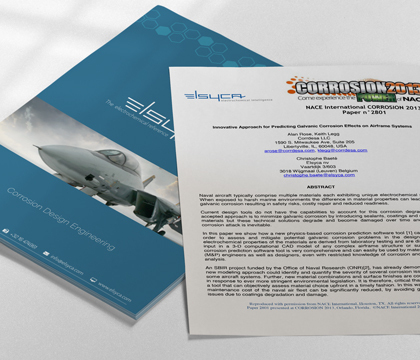
Predicting Galvanic Corrosion Effects on Airframe Systems (NACE 2013)
Innovative Approach for Predicting Galvanic Corrosion Effects on Airframe Systems

Predicting Galvanic Corrosion Effects on Airframe Systems (NACE 2013)
Christophe Baeté, Elsyca n.v.; Alan Rose; Keith Legg, Corrdesa LLC.
Abstract
Naval aircraft typically comprise multiple materials each exhibiting unique electrochemical properties. When exposed to harsh marine environments the difference in material properties can lead to severe galvanic corrosion resulting in safety risks, costly repair and reduced readiness.
Current design tools do not have the capabilities to account for this corrosion degradation. The accepted approach is to minimize galvanic corrosion by introducing sealants, coatings and other barrier materials but these technical solutions degrade and become damaged over time and eventually corrosion attack is inevitable.
In this paper we show how a new physics-based corrosion prediction software tool can be used, in order to assess and mitigate potential galvanic corrosion problems in the design phase. The electrochemical properties of the materials are derived from laboratory testing and are directly used as input in a 3-D computational CAD model of any complex airframe structure or subsystem. The corrosion prediction software tool is very comprehensive and can easily be used by materials & process (M&P) engineers as well as designers, even with restricted knowledge of corrosion and finite element analysis.
An SBIR project funded by the Office of Naval Research (ONR), has already demonstrated that this new modeling approach could identify and quantify the severity of several corrosion issues observed in some aircraft systems. Further, new material combinations and surface finishes are constantly evolving in response to ever more stringent environmental legislation. It is therefore, critical that engineers have a tool that can objectively assess material choice upfront in a timely fashion. In this way, downtime and maintenance cost of the naval air fleet can be significantly reduced, by avoiding galvanic corrosion issues due to coatings degradation and damage.
Download pdf